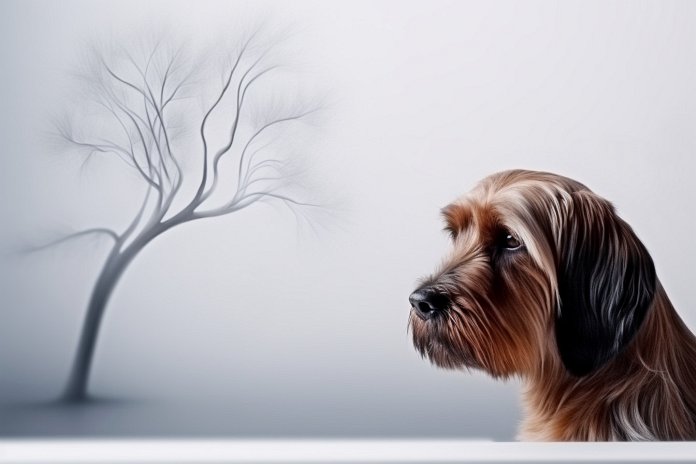
Despite its name, the Bascottie is not an Italian cookie but rather a mixed breed dog. It is a cross between a Basset Hound and a Scottish Terrier. The Bascottie takes after its Scottish Terrier parent in terms of appearance and other characteristics. However, it also inherits the Basset Hound’s low-to-the-ground proportions and sturdy legs.
The Bascottie is a friendly and lively dog, surprising given its size and long body. With proper socialization from a young age, they can get along well with other dogs and even treat cats like family. Their coat can come in various colors such as brown, white, and brindle, and they typically have black, wiry hair.
In conclusion, the Bascottie is a unique mixed breed dog that combines the traits of a Basset Hound and a Scottish Terrier. Despite its name, it has no relation to Italian cookies. This energetic and sociable dog can make a great companion, especially when properly trained and socialized.
Ahead, we look at Bascottie dog breed, its history, personality, pros and cons of owning an Bascottie, characteristics, and must-see facts. We will also examine how to care for this breed and more. Prepare for a tail-wagging adventure into the world of Bascotties!
| Dog Breed | Bascottie |
| Size | Medium |
| Weight | 18-45 lbs (average) |
| Height | 10-15″ (average) |
| Location | United States |
| Ancestry | Basset Hound, Scottish Terrier |
| Date of Origin | 2000s |
| Group | Companion |
| Life Expectancy | 11-13 years |
| Price | $300 – $500 |
| Family | Canidae |
| Scientific Name | Canis Lupus Familiaris |
📖 Breed History
The Bascottie is a modern breed that is a mix of the Basset Hound and the Scottish Terrier. While it doesn’t have a separate history of its own, it inherits most of its traits from the Scottish Terrier, which has a long history. The Scottish Terrier’s ancestors, the Scotch Terriers, were first mentioned by the Romans in 55 BC. These small dogs were known for being agile hunters that would chase their prey underground. They were called Terrarii, which means workers of the earth in Latin. Over time, the Terrier group thrived as earth dogs in Scotland, England, France, and parts of Germany. By the 1800s, the Scottish Terrier had become a wire-haired small Terrier of the Skye group, distinguishing it from the smooth coated Terriers of England.
The Basset Hound, on the other hand, originated in France and is believed to be a short-legged mutation of the St. Hubert Hound, which is now known as the Bloodhound. Originally bred as curiosities for the aristocracy, the Basset Hound became popular among common people after the French Revolution when they realized they could keep up with these dogs on foot during hunts. This gave the Basset Hound a position among hunting companion breeds. Today, the Bascottie resembles the Scottish Terrier more than the Basset Hound, but it still retains the distinctive short legs of the Basset Hound.

🐕 Bascottie Appearance
The Bascottie is a diminutive to medium-sized cross between the Scottish Terrier and the Basset Hound. With a wiry, often black coat and traits matching the Scottish Terrier, it could be challenging to distinguish your Bascottie from the Scottish Terrier breed. However, compared to Scottish Terriers, the ears are significantly larger, positioned lower on the head, and the nose is slightly bigger. Scottish Terriers are short-legged yet proportionate to their size, unlike the Basset Hound is too tall. The Bascottie has more robust legs than the Scottish Terrier and a somewhat longer body, maintaining the exaggerated appearance. Like its Scottish Terrier father, the Bascottie’s tail is carried level with the back and may curl slightly, but it can also stand on end when the dog gets aroused.
| 👀 Eye Color | Varies |
| 🐽 Nose Color | N/A |
| 🐕 Coat Color | Ranges |
⚡ Fun Fact: Bascottie dogs are a social breed. They enjoy being around people or other animals. This breed doesn’t tolerate being left alone.
🐶 Traits & Temperament of Bascottie
We are reviewing and looking at the data related to the temperament, behavior, and traits of this dog breed. Please stay tuned for our update available shortly.
🤝 Are Bascotties Friendly or Aggressive?
Bascottie dogs are known for their friendly nature towards other animals, making them a great choice for households with other pets. They are also comfortable around strangers, making them stranger-friendly dogs. Bascotties particularly enjoy the company of children and are considered to be very kid-friendly. They are also cat-friendly and get along well with other dogs, making them a good option for those looking to have multiple dogs or participate in dog meetups. Additionally, Bascotties are often recommended as a suitable breed for elderly individuals due to their qualities and characteristics that cater to their needs.
This breed is known for being:
- Playful
- Independent
- Alert
- Friendly
- Affectionate
- Quick
- Devoted
- Gentle
- Tempered
- Sweet
- Tenacious
- Selfish
🐩 Bascottie Care & Maintenance
A Bascottie’s double layer prevents the longer hair from shedding as frequently. This combination will look and feel good with regular brushing, and different brushes should be used once a week. To maintain the coat appearing healthy, the best grooming tools are stiff brushes, hound gloves, and wide-toothed combs. Despite being raised by a heavy drooling Basset Hound, the Bascottie is not known to drool, and his pristine coat prevents him from acquiring any hound odors. The Bascottie’s ears are considerably smaller than those of a Basset Hound, which have larger ears. Despite their tiny size, it is always recommended to clean your Bascottie’s ears once a week with a veterinary solution to get rid of wax, dirt, and debris.
Bascottie dogs are not heavy shedders and do not lose a lot of hair. Shedding is a normal part of their hair growth cycle. The amount and frequency of hair loss can vary depending on the dog’s overall health and the breed they belong to. Additionally, it is recommended to give them a bath every 4-6 weeks to maintain their cleanliness and hygiene.
🍖 Food: We recommend few cups daily, costing you about $0.49 – $1.49 daily, or roughly $30.00 a month.
🐾 Exercise: Bascottie dogs have an average exercise need. This breed is satisfied with short walks every weekday and a long ones on weekends.
This dog breed requires to be walked for roughly few miles per week, which equates to about 15 – 35 minutes of physical activity daily. This consistent moderate exercise regimen will help maintain their physical wellness and significantly contribute to their mental stimulation. Consciously setting aside this time for your furry friend can dramatically enhance their life quality, helping them stay energetic, healthy, and mentally alert.
Did you know: Bascottie dogs have an average energy level, so if you live a semi-active life, this breed can be a good choice for you.
❤️🩹 Bascottie Health & Issues
Some of the major concerns for Bascottie Dog Breed can be:
- Patellar Luxation
- Intervertebral Disc Disease
- Hip And Elbow Dysplasia
- Von Willebrand’s Disease
- Hypothyroidism
- Bleeding Disorder
While minor concerns include:
- Ear Infections
- Entropion
- Ectropion
- Glaucoma
- Bloat
🤧 Important: Is Bascottie hypoallergenic? No.
✨ Bonus: Check out cool, creative, and funny names for Bascottie.
⚡ Bascottie Dog Breed Facts
What makes the Bascottie a great choice for families with young children?
The Bascottie is a great choice for families with young children because they are outgoing and active, making them excellent playmates for kids. They are known to be gentle and patient, making them a suitable companion for children of all ages.
Is the Bascottie breed considered a suitable breed for apartment living?
The Bascottie breed is considered suitable for apartment living. Despite their active nature, they adapt well to smaller living spaces as long as they receive regular exercise and mental stimulation. They are not excessively noisy and generally do well in apartment environments.
How much exercise does a Bascottie require compared to other breeds?
The Bascottie requires a moderate amount of exercise compared to other breeds. Daily walks and playtime are essential to keep them physically and mentally stimulated. They have good energy levels and will enjoy activities such as running, hiking, or playing fetch.
Is the Bascottie breed known for being good with other pets?
The Bascottie breed is known for being good with other pets. They usually get along well with other dogs and can form strong bonds with them. With proper socialization, they can also coexist peacefully with cats and other small animals.
What are other low-maintenance dog breeds similar to the Bascottie?
Some low-maintenance dog breeds similar to the Bascottie include the French Bulldog, Boston Terrier, and Cavalier King Charles Spaniel. These breeds require less exercise and grooming compared to others while still being friendly and good with families.
What are the common health issues that Bascotties are prone to?
Common health issues that Bascotties are prone to include allergies, hip dysplasia, and eye problems. Regular vet check-ups and a healthy diet are important to ensure their well-being and prevent potential health issues.
Are Bascotties known to be easy to train compared to other breeds?
Bascotties are known to be relatively easy to train compared to other breeds. They are intelligent and eager to please, making them quick learners. Consistent positive reinforcement methods and early socialization are key to their training success.
Are Bascotties more prone to separation anxiety compared to other breeds?
Bascotties can be prone to separation anxiety, especially if they are not properly trained or socialized. They form strong bonds with their families and may become anxious when left alone for long periods. Crate training and gradually increasing alone time can help alleviate this issue.
Are there any dog breeds similar to the Bascottie that are suitable for people with allergies?
Some dog breeds similar to the Bascottie that are suitable for people with allergies include the Bichon Frise, Poodle, and Portuguese Water Dog. These breeds have hypoallergenic coats that produce fewer allergens, making them easier for allergy sufferers.
What sizes of dogs similar to the Bascottie are best for individuals or families with limited space?
Smaller-sized dogs similar to the Bascottie, such as the French Bulldog, Boston Terrier, or Dachshund, are best for individuals or families with limited space. These breeds can adapt well to living in apartments or smaller homes due to their size and exercise needs.
Is the Bascottie breed known to be good with children with special needs?
The Bascottie breed is known to be good with children, including those with special needs. Their gentle and patient nature makes them suitable companions for children with different abilities. However, as with any dog, supervision and teaching children how to interact with dogs is essential.
How does the grooming and shedding needs of the Bascottie?
The grooming and shedding needs of the Bascottie are relatively low compared to other breeds. Their wiry hair requires occasional brushing to prevent matting, and they shed minimally. However, regular ear cleaning and nail trimming are important for their overall grooming routine.
We use reliable and publicly available data and resources such as AKC and American Canine Registry to ensure that Bascottie dog breed information is accurate and up to date. If you spot an error, please don’t hesitate to bring it to our attention.